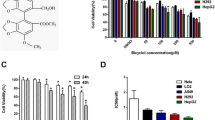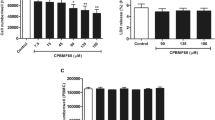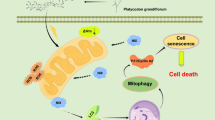Summary
Poly (ADP-ribose) polymerase-1 (PARP-1) inhibitors and histone deacetylase (HDAC) inhibitors have recently emerged as promising anticancer drugs. The aim of this study was to investigate the effect of combination treatment with the PARP inhibitor PJ34 and HDAC inhibitor SAHA on the proliferation of liver cancer cells. Cell proliferation and apoptosis were assessed in three human liver cancer cell lines (HepG2, Hep3B and HCC-LM3) treated with PJ34 (8 μmol/L) and SAHA (1 μmol/L), alone or combined, by Cell Counting Kit-8 assay and flow cytometry, respectively. The nude mice bearing subcutaneous HepG2 tumors were administered different groups of drugs (10 mg/kg PJ34, 25 mg/kg SAHA, 10 mg/kg PJ34+25 mg/kg SAHA), and the inhibition rates of tumor growth were compared between groups. The results showed that combined use of PJ34 and SAHA could synergistically inhibit the proliferation of liver cancer cell lines HepG2, Hep3B and HCC-LM3. The apoptosis rate of HepG2 cells treated with PJ34+SAHA was significantly higher than that of HepG2 cells treated with PJ34 or SAHA alone (P<0.05). In vivo, the tumor inhibition rates were 53.5%, 61.4% and 82.6% in PJ34, SAHA and PJ34+SAHA groups, respectively. The combined use of PJ34 and SAHA could significantly inhibit the xenograft tumor growth when compared with use of PJ34 or SAHA alone (P<0.05). It was led to conclude that PJ34 and SAHA can synergistically suppress the proliferation of liver cancer cells.
Similar content being viewed by others
References
Lafaro KJ, Demirjian AN, Pawlik TM. Epidemiology of hepatocellular carcinoma. Surg Oncol Clin N Am, 2015,24(1):1–17
Bruix J, Gores GJ, Mazzaferro V. Hepatocellular carcinoma: clinical frontiers and perspectives. Gut, 2014,63(5):844–855
Ma L, Chua MS, Andrisani O, et al. Epigenetics in hepatocellular carcinoma: an update and future therapy perspectives. World J Gastroenterol, 2014,20(2):333–345
Yang SF, Chang CW, Wei RJ, et al. Involvement of DNA damage response pathways in hepatocellular carcinoma. Biomed Res Int, 2014,2014:153867
Beck C, Robert I, Reina-San-Martin B, et al. Poly(ADP-ribose) polymerases in double-strand break repair: Focus on PARP1, PARP2 and PARP3. Exp Cell Res, 2014,329(1):18–25
McCabe N, Turner NC, Lord CJ, et al. Deficiency in the repair of DNA damage by homologous recombination and sensitivity to poly(ADP-ribose) polymerase inhibition. Cancer Res, 2006,66(16):8109–8115
Bast RC Jr, Mills GB. Personalizing therapy for ovarian cancer: BRCAness and beyond. J Clin Oncol, 2010,28(22):3545–3548
De Summa S, Pinto R, Sambiasi D, et al. BRCAness: a deeper insight into basal-like breast tumors. Ann Oncol, 2013,24(8):13–21
Robert T, Vanoli F, Chiolo I, et al. HDACs link the DNA damage response, processing of double-strand breaks and autophagy. Nature, 2011,471(7336):74–79
Lahue RS, Frizzell A. Histone deacetylase complexes as caretakers of genome stability. Epigenetics, 2012,7(8):806–810
Clamp A, Jayson G. PARP inhibitors in BRCA mutation-associated ovarian cancer. Lancet Oncol, 2015,16(1):10–12
Huang SH, Xiong M, Chen XP, et al. PJ34, an inhibitor of PARP-1, suppresses cell growth and enhances the suppressive effects of cisplatin in liver cancer cells. Oncol Rep, 2008,20(3):567–572
Nogami Y, Banno K, Kisu I, et al. Current status of molecular-targeted drugs for endometrial cancer. Mol Clin Oncol, 2013,1(5):799–804
Gourzones-Dmitriev C, Kassambara A, Sahota S, et al. DNA repair pathways in human multiple myeloma: role in oncogenesis and potential targets for treatment. Cell Cycle, 2013,12(17):2760–2773
Bose P, Dai Y, Grant S. Histone deacetylase inhibitor (HDACI) mechanisms of action: emerging insights. Pharmacol Ther, 2014,143(3):323–336
Garcia-Manero G, Yang H, Bueso-Ramos C, et al. Phase 1 study of the histone deacetylase inhibitor vorinostat (suberoylanilide hydroxamic acid [SAHA]) in patients with advanced leukemias and myelodysplastic syndromes. Blood, 2008,111(3):1060–1066
Lee JH, Choy ML, Ngo L, et al. Histone deacetylase inhibitor induces DNA damage, which normal but not transformed cells can repair. Proc Natl Acad Sci USA, 2010,107(33):14639–14644
Alli E, Solow-Cordero D, Casey SC, et al. Therapeutic targeting of BRCA1-mutated breast cancers with agents that activate DNA repair. Cancer Res, 2014,74(21):6205–6215
Pothuri B. BRCA1- and BRCA2-related mutations: therapeutic implications in ovarian cancer. Ann Oncol, 2013,24(8):22–27
Duvic M, Talpur R, Ni X, et al. Phase 2 trial of oral vorinostat (suberoylanilide hydroxamic acid, SAHA) for refractory cutaneous T-cell lymphoma (CTCL). Blood, 2007,109(1):31–39
Zhou C, Ji J, Shi M, et al. Suberoylanilide hydroxamic acid enhances the antitumor activity of oxaliplatin by reversing the oxaliplatininduced Src activation in gastric cancer cells. Mol Med Rep, 2014,10(5):2729–2735
Xiao W, Graham PH, Hao J, et al. Combination therapy with the histone deacetylase inhibitor LBH589 and radiation is an effective regimen for prostate cancer cells. PLoS One, 2013,8(8):74253
Adimoolam S, Sirisawad M, Chen J, et al. HDAC inhibitor PCI-24781 decreases RAD51 expression and inhibits homologous recombination. Proc Natl Acad Sci USA, 2007,104(49):19482–19487
Li X, Chen BD. Histone deacetylase inhibitor M344 inhibits cell proliferation and induces apoptosis in human THP-1 leukemia cells. Am J Biomed Sci, 2009,1(4):352–363
Petruccelli LA, Pettersson F, Del Rincon SV, et al. Expression of leukemia-associated fusion proteins increases sensitivity to histone deacetylase inhibitorinduced DNA damage and apoptosis. Mol Cancer Ther, 2013,12(8):1591–1604
Author information
Authors and Affiliations
Corresponding author
Additional information
This project was supported by grants from the National Natural Science Foundation of China (No. 81172293) and the New Century Excellent Talent Foundation of Ministry of Education of China (No. NCET-04-0701).
Rights and permissions
About this article
Cite this article
Liang, By., Xiong, M., Ji, Gb. et al. Synergistic suppressive effect of PARP-1 inhibitor PJ34 and HDAC inhibitor SAHA on proliferation of liver cancer cells. J. Huazhong Univ. Sci. Technol. [Med. Sci.] 35, 535–540 (2015). https://doi.org/10.1007/s11596-015-1466-6
Received:
Revised:
Published:
Issue Date:
DOI: https://doi.org/10.1007/s11596-015-1466-6




